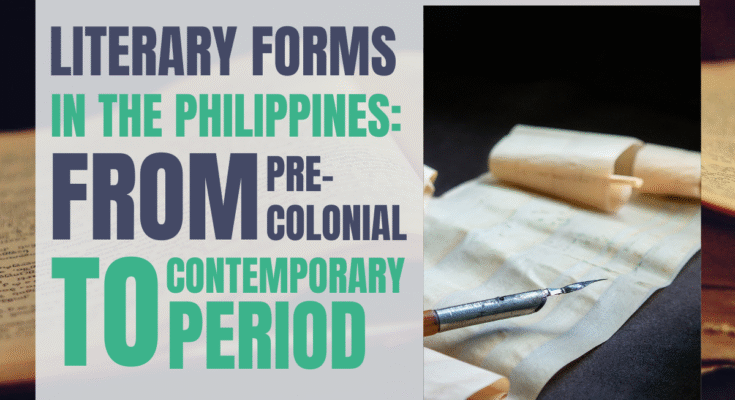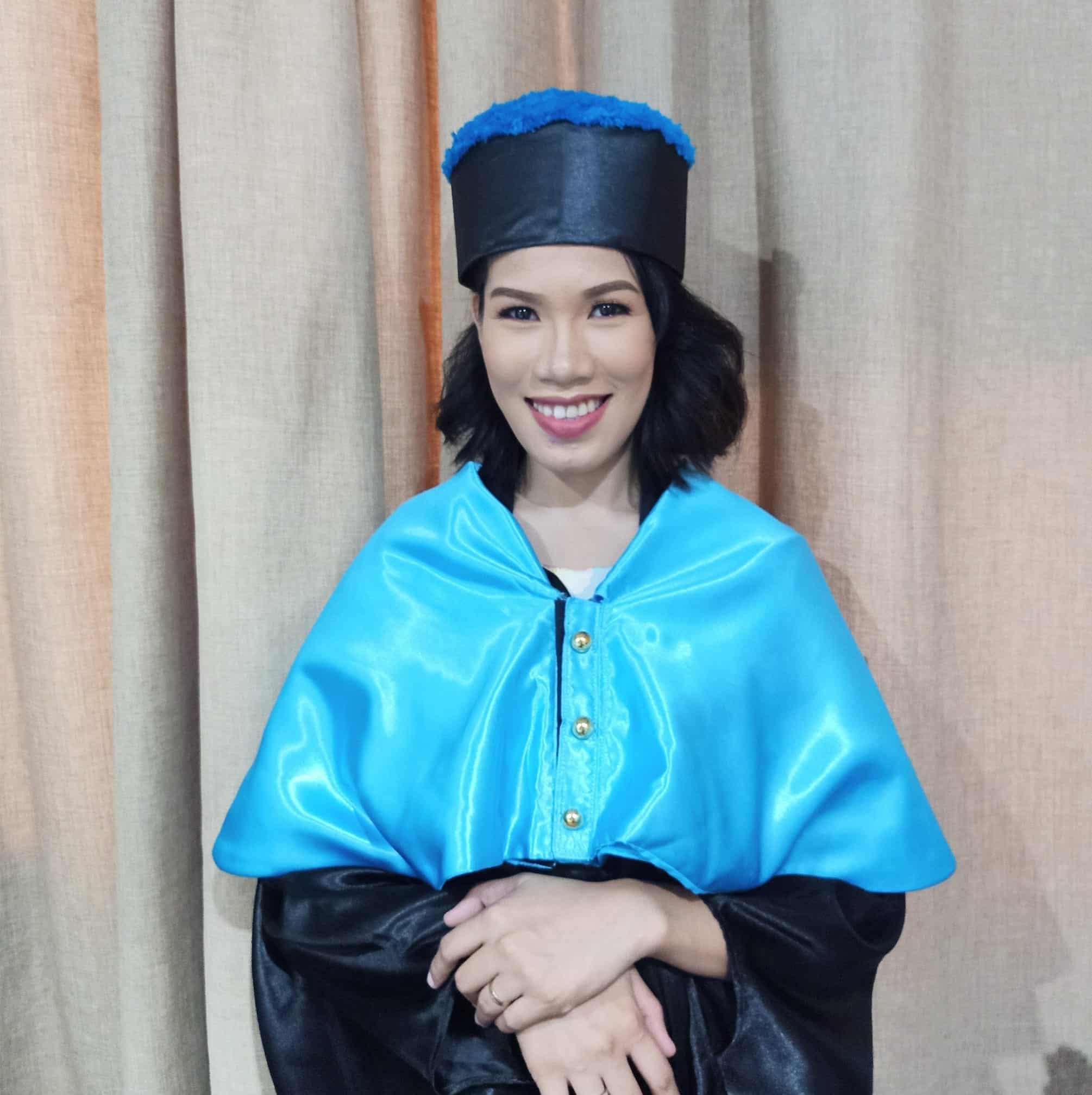What are the literary forms in the Philippines?
Philippine literature is rich and diverse. It has grown and changed alongside the country’s history. To truly understand it, we must look at its roots—from the early traditions of native communities to the written works of later generations.
Many Filipinos don’t know much about our early literature. That’s because for a long time, we were taught that Philippine history only began in 1521, when the Spanish arrived.
This idea erased the value of our pre-colonial oral traditions. Today, more Filipino writers and artists are working to bring back awareness and pride in our ethnic and local literature. The strong sense of Filipino identity that grew in the 1960s and 1970s helped support this movement.
12+ Literary Forms in the Philippines From Pre-Colonial to Contemporary Period
Pre-Colonial Times
Thanks to Filipino archaeologists and researchers, we now know more about our pre-colonial culture. Ancient writings from Spanish, Chinese, and Arabic visitors also offer valuable information.
Before colonization, Filipinos passed stories, songs, riddles, and poems from one generation to the next. These forms reflect our close ties with other Southeast Asian cultures.
1. Riddles (Bugtong)
Riddles use metaphors to describe things in a fun and puzzling way. They challenge the mind and often reveal how observant and witty a person is. Riddles are known as bugtong (Tagalog), tigmo (Cebuano), paktakon (Ilongo), and patototdon (Bicol).
Some riddles are light and clever, while others are funny or even a bit inappropriate, like the Gaddang example:
- “Gongonan nu usin y amam / Maggirawa pay sila y inam, / Campana”
- (Pull your father’s private part / Your mother will scream / Like a bell.)
2. Tanaga
The tanaga is a short Filipino poem. It has four lines with seven syllables each and rhymes. It shares deep thoughts and lessons.
Other similar poetic forms include:
- Daraida and Daragilon (Panay)
- Basahanon (Bukidnon)
3. Folk Song
Folk songs express daily life, love, work, and culture. Many are simple, repetitive, and easy to remember.
Some examples:
- Parang Sabil (Tausug heroic ballads)
- Ili-ili (lullabies)
- Harana (serenades)
- Bayok (Maranao love songs)
- Ambahan (Mangyan poetry)
- Kalusan and Mambayu (work songs)
- Tagay (drinking songs)
- Kanogon (funeral songs)
4. Folk Narratives
Folk narratives include epics and folk tales. These explain why animals act a certain way, how natural features like mountains or waterfalls came to be, or how the world began. Fables also teach moral lessons using animals as characters.
Our country’s epics are not national but tribal. Each group has its own epic that reflects their history, values, and beliefs. These stories include heroic acts and supernatural events.
They are performed by special singers or chanters, often with music and dancing. These chanters are considered community treasures.
Examples:
- Lam-ang (Ilocano)
- Hinilawod (Sulod)
- Kudaman (Palawan)
- Darangen (Maranao)
- Ulahingan (Livunganen-Arumanen Manobo)
- Mangovayt Buhong na Langit (Manobo)
- Ag Tobig neg Keboklagan (Subanon)
- Tudbulol (T’boli)
The Spanish Colonial Tradition
Spain ruled the Philippines for over 300 years. Religion and European ideas changed our literature. The Spanish introduced theater, religious books, and new poetic forms.
They also brought in ideas about freedom and justice. These ideas would later inspire Filipino writers to speak out.
Literature during this time was divided into two types:
- Secular Prose and Poetry
- Religious Prose and Poetry
5. Religious Prose and Poetry
Religious poems were written by ladino poets who knew both Spanish and Tagalog. These poems were included in prayer books and used to teach Christian values.
One example is Fernando Bagonbanta’s “Salamat nang walang hanga / gracias de sin sempiternas” (“Unending Thanks”) from Memorial de la vida cristiana en lengua tagala (1605).
Dalit
Dalit are meditative religious verses. They don’t follow a strict rhyme or meter, but some have eight syllables per line. They are serious and spiritual.
Pasyon
The pasyon tells the story of Jesus Christ’s suffering and resurrection. It is written in five-line stanzas with eight syllables per line (quintillas).
Gaspar Aquino de Belen’s “Ang Mahal na Passion ni Jesu Christong Panginoon natin na tola” (1704) is the earliest known pasyon.
Many regions created their own pasyons in languages like Ilocano, Pangasinan, Cebuano, Waray, and others.
There were also religious stories written in prose, such as:
- Dialogo (dialogue)
- Manual de Urbanidad (conduct guide)
- Ejemplo (moral example)
- Tratado (treatise)
Famous works include:
- Pagsusulatan ng Dalawang Binibini na si Urbana at Feliza by Modesto de Castro (1864)
- Ang Bagong Robinson by Joaquin Tuason (1879), adapted from Daniel Defoe’s Robinson Crusoe
6. Secular Prose and Poetry
As the middle class grew, more people could afford books. They also had access to European-style education. Because of this, secular or non-religious literature became more popular.
Love poems became widespread. These poems usually told stories of loyal lovers, harsh heartbreaks, and romantic rivals.
Famous secular poets include:
- Jose Corazon de Jesus (Huseng Sisiw)
- Francisco Balagtas
- Leona Florentino
- Jacinto Kawili
- Isabelo de los Reyes
- Rafael Gandioco
Awit and Korido
These are narrative poems:
- Awit uses 12-syllable lines (dodecasyllabic quatrains)
- Korido uses 8-syllable lines (octosyllabic quatrains)
These are colorful tales of adventure, often based on European stories. They were made for singing or chanting.
Examples:
- Gonzalo de Cordoba
- Ibong Adarna
- Florante at Laura by Balagtas (1838-1861)
The Start of Change in Philippine Literature
The Rise of the Ilustrados
In the 19th century, change began to stir in Philippine literature.
- Filipino intellectuals who studied in Europe—known as ilustrados—began writing about the negative effects of Spanish colonization.
- These intellectuals were joined by ordinary Filipinos who were also calling for reform.
Together, they formed a powerful group of writers and thinkers, including:
- Jose Rizal
- Marcelo H. del Pilar
- Mariano Ponce
- Emilio Jacinto
- Andres Bonifacio
The Propaganda Movement and National Awakening
This movement led to the birth of the Propaganda Movement.
- Writers produced political essays and novels that exposed the abuses of the Spanish government.
- Jose Rizal’s two novels—Noli Me Tangere and El Filibusterismo—played a major role in awakening the national spirit.
- These works helped spark the Philippine Revolution, which aimed to end Spanish rule and gave rise to Filipino nationalism.
Early Filipino Novels in Spanish
While Rizal’s works were political, other novels focused more on culture.
- Pedro Paterno’s Ninay (1885) is considered the first Filipino novel.
- Ninay encouraged other writers, such as:
- Jesus Balmori
- Antonio M. Abad
- However, this tradition of writing novels in Spanish did not grow significantly.
Spanish-Language Journalism and Fiction
Other writers published essays and short stories in Spanish newspapers and journals like:
- La Vanguardia
- El Debate
- Renacimiento Filipino
- Nueva Era
Notable Spanish-language writers and essayists included:
- Claro M. Recto
- Teodoro M. Kalaw
- Epifanio de los Reyes
- Vicente Sotto
- Trinidad Pardo de Tavera
- Rafael Palma
- Enrique Laygo – known for Caretas (Masks, 1925)
- Jesus Balmori – known for mastering prosa romantica or romantic prose
The Decline of Spanish and the Rise of English
When English became the official medium of instruction during the American period:
- Spanish literary writing began to fade.
- By the 1930s, writing in English had become more common than Spanish.
Even so, the romantic style found in awit and korido continued in the novels of:
- Magdalena Jalandoni, who kept the tradition alive through her works in Spanish.
Patriotic Writing and Vernacular Literature
Patriotic literature also lived on under American rule.
- Many writers turned to vernacular languages (like Tagalog, Ilocano, Hiligaynon) to write poems and short stories.
- Some of these were modern adaptations of works from the Spanish period, showing that the Spanish influence remained strong in form, even as the language declined.
The American Colonial Period
When the U.S. took over, they introduced free public education and made English the language of instruction. New forms of literature emerged.
7. Free Verse
Jose Garcia Villa, later named National Artist for Literature, wrote in free verse and believed in “Art for art’s sake.”
Angela Manalang Gloria also used free verse. Her poems talked about taboo topics like forbidden love. She was ahead of her time.
Even with censorship, more writers produced bold works. Literature in native languages grew, especially through popular magazines like Liwayway and Bisaya.
8. Modern Verses
The Balagtas tradition lived on until Alejandro G. Abadilla introduced modernism in poetry. He influenced a new wave of poets in the 1960s, such as:
- Rolando S. Tinio
- Virgilio S. Almario
- Pedro I. Ricarte
9. Modern Short Story
Filipino writers adapted quickly to the short story format. These were published in magazines like Philippines Free Press, College Folio, and Philippines Herald.
- Arturo B. Rotor and Manuel E. Arguilla also became masters of the form.
- Paz Marquez Benitez’s “Dead Stars” (1925) was the first successful English short story by a Filipino.
10. Dali or Pasingaw
Writers in the provinces wrote in their native tongues. Some crafted short narratives known as dali or pasingaw.
Examples:
- Lope K. Santos
- Valeriano Hernandez Peña
- Patricio Mariano
These stories often mixed romantic tradition with American pop culture or European tales.
For instance:
- F.P. Boquecosa adapted Tarzan and wrote Ang Palad ni Pepe, inspired by Charles Dickens’ David Copperfield.
Realist writers like Lope K. Santos and Faustino Aguilar kept the local novel alive. While English novels were few, vernacular novels continued and were published in magazines like:
- Liwayway
- Bisaya
- Hiligaynon
- Bannawag
11. Modern Essays
From the 1920s onward, essays in English became a powerful form. Leading essayists included:
- Carlos P. Romulo
- Jorge Bocobo
- Pura Santillan Castrence
They wrote on serious and light topics. Some critics, like Ignacio Manlapaz and Leopoldo Yabes, developed essay writing further.
In 1940, Salvador P. Lopez won the Commonwealth Literary Award with his essay Literature and Society. He said literature should have meaning and purpose—not just beauty. He opposed Villa’s idea of “Art for art’s sake.”
12. New Criticism
Toward the end of the American period, writers focused more on craft. This came with the rise of “New Criticism.”
Writers became more concerned with structure and form. However, this also led to a lower appreciation for literature in native languages—a conflict that would return in later years.
The Contemporary Period
Philippine literature continues to thrive in many languages.
After Martial Law and during the 1960s–1970s, more writers became committed to social and political themes. Today, writers continue to explore different subjects:
- Social and gender issues
- Cultural identity
- Personal reflections
Writers’ workshops and the internet give them more tools to improve their craft.
Literary awards, such as:
- Don Carlos Palanca Memorial Awards
- Philippines Free Press Awards
- Philippine Graphic Awards
- Home Life
- Panorama
…have motivated writers to share their stories and be recognized.
Because Philippine literature was once a required subject in college, and more attention is being given to regional works, writers have a bigger audience.
We hope that Philippine literature will continue to grow and gain a place in world literature.
Want to learn more?
If you’re looking for more resources about literature, then make sure to browse my website.




